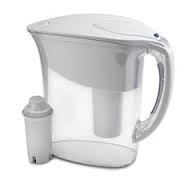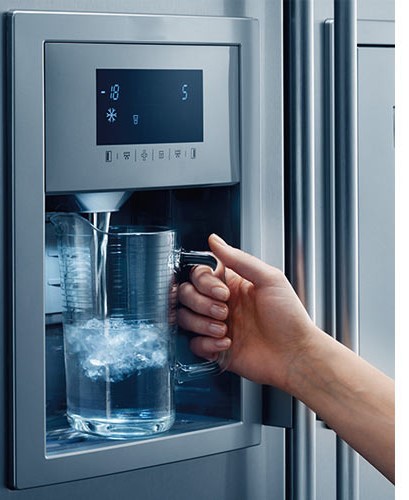Water is THE most important nutrient that our body needs to stay healthy and in balance. H2O is truly the foundation of life. No amount of vitamins or supplements can substitute the vital life-sustaining properties found in purified water. (see Proper Hydration Is Important!)
Unfortunately, however, it can often be challenging to have access to good tasting, healthful, and uncontaminated drinking water. Below are a few of the water options we can choose from as consumers.
Is tap water safe to drink?

Municipal tap water is generally treated with chlorine to make it safe for human consumption. However, the unpleasant taste and odor associated with tap water often deter people from drinking sufficient quantities of water. (see Dangers of Dehydration). Also, chlorine reacts with various organic and inorganic elements present in water to create byproducts that can be toxic when consumed in large doses (e.g. trihalomethanes,
Many cities also add fluoride as a public health measure to reduce tooth decay. However, many studies have shown that long-term ingestion of fluoride can have a negative impact on our health, including effects on the thyroid, bones, digestive system, brain, and even the tooth enamel it’s supposed to help (a condition known as fluorosis).
Municipal tap water can also be laced with varying levels of unwanted chemicals and contaminants including heavy metals, volatile organic compounds (VOCs), sulfates, nitrates, pharmaceuticals and hormones, and radioactive elements. Tap water can also become unfit for human consumption during boil water advisories when a community’s drinking water
That being said, municipal tap water is also the most environmentally friendly way to consume water. The solution to rising concerns about water safety is not to turn to bottled water, which is polluting and not necessarily healthful but to find a cost-effective way to safely decontaminate water. Berkey water filtration systems are the most ecological and cost-effective way to produce safe, pure and refreshing drinking water from any treated or untreated water source.
Carbon Water Filtration Systems
There are two primary types of carbon water filtration systems on the market: granular activated carbon (GAC), such as the small granules found in filtering pitchers, and block carbon which is a finer, denser material typically found in cartridges such as those used in under-counter filters and refrigerator filters. There are many factors that affect filtration efficiency, including the amount of carbon in the unit, the pore size (measured in microns) and the flow rate which affects the length of time contaminants spend in contact with the carbon.

Carbon is effective in removing the bad tastes and odors associated with tap water as well as certain organic compounds. However, carbon performs rather poorly in removing dissolved inorganic contaminants and heavy metals such as minerals, salts, antimony, arsenic, asbestos, barium, beryllium, cadmium, chromium, copper, fluoride, lead, mercury, nickel, nitrates, selenium, sulfate, thallium 
Carbon block water filters rated at a pore size of 0.5 microns or smaller can remove some larger, dangerous microorganisms, such as giardia and cryptosporidium, but water filters with larger pore size or 1 or 5 microns will be ineffective for bacteria removal. Furthermore, viruses are too small to be removed by carbon, as they usually range between 20 and 400 nanometers in size. As for GAC filters, they can suffer from a phenomenon called channeling where the water pressure forces channels to open up in the loose carbon granules. Some of the water, following the path of least resistance, will flow through the channel and not come into contact with the carbon filtration medium. Consequently, some of the water flowing through a GAC filter may not have been filtered at all, and there is no way of knowing the extent to which the water still contains harmful contaminants or not
As such, most carbon water filter companies are unable or unwilling to provide consumers with independent lab test reports to show the detailed list of contaminants removed as well as the removal efficiency, expressed as a percentage. On the other hand, New Millenium Concepts Ltd., the manufacturer of Berkey water purifiers, is one of the only companies on the market that publish independent lab test reports that show the 99+% removal rate of hundreds of organic and inorganic contaminants.
Finally, a little-known fact is that carbon water filters lower the pH of water by about 1 point on the pH scale, making water more acidic than the unfiltered tap water.
Reverse Osmosis Water Filtration Systems
Reverse osmosis (RO) water filtration systems are widely available, and their popularity has increased significantly over the past 10 or 15 years with growing concerns over the safety of drinking water. RO systems are extremely effective water purification systems that will remove contaminants found in water to an efficiency of 95-99%, including fluoride, heavy metals, chemicals, pharmaceuticals and more.
RO purified water, however, can also have a number of undesirable long-term effects on our health and the environment:

-
In addition to removing contaminants, RO water filtration systems also remove all dissolved minerals naturally present in water. Purified water acts as a natural solvent in our body. As RO drinking water contains no minerals at all, it becomes a more aggressive solvent that robs the body of essential minerals with every glass of water you drink (see pH Balanced Healthful Water).
-
Treating water through an RO water filtration system drops the pH of
water to about 5, which is more than 100 times more acidic than our body’s natural pH of 7,35. -
Reverse osmosis treatment removes all the vibrational frequency or energy that is naturally present in purified water and that our body thrives on. This is why water treated by this process is often referred to as “dead” water.
-
Reverse osmosis treatment used alone is not an effective treatment with untreated water sources that may contain bacteria and viruses.
-
RO water purification systems waste a lot of purified water: for every liter of filtered water produced, RO systems can generate anywhere between 4 and 10 liters of wastewater that simply goes down the drain.
Bottled Water
Bottled water is expensive and has a huge environmental impact. , not only due to the plastic waste generated by the bottles themselves but also due to the extraction and consumption of the petroleum products used to produce the plastic bottles and to transport the bottled water to the point of sale. Furthermore, it takes 3 liters of water to produce a 1-liter bottle of water. The other 2 liters go down the drain! (see Environmental Concerns)
The bottled-water industry has seen skyrocketing growth in recent years, and the range of consumer products keeps expanding in response to people’s growing concerns about the safety of tap water. Here are some of the main types of bottled waters on the market:
- Springwater
Spring water can vary enormously depending on the source. Variables include the type of minerals found in the source water, mineral concentration (in mg/l or ppm) and pH value, which generally ranges from 7 to 8. Few brands indicate the pH value on the
- Reverse Osmosis purified water
Reverse osmosis (RO) water, also referred to as demineralized water, is produced using a multi-stage water filtration system that includes a semi-porous membrane capable of filtering out 95-99% of contaminants found in water. However, the treatment process produces a huge amount of wastewater as the RO system’s membrane must be continuously
- Distilled water
Distilled water contains only H2O molecules and is the purest form of water. The distillation process reproduces the natural cycle of water through evaporation and condensation of water molecules. Distilled water acts as an excellent solvent, but if used continuously without compensating with mineral supplementation, it can have a demineralizing effect on our body. Distilled water is dead water, devoid of minerals and vibrational frequencies.
- Carbonated mineral water
Carbonated water is generally rich in alkaline minerals, but the carbonated gas lowers the pH to around 5, or 100 times more acid than neutral.
Potable water from well
Living Raw Drinking Water
 Water harvested directly from a spring is
Water harvested directly from a spring is
Find out how you can transform your Berkey water into pure, living, structured, alkaline water with the Vitalizer Plus Vortex Water Revitalizer.

